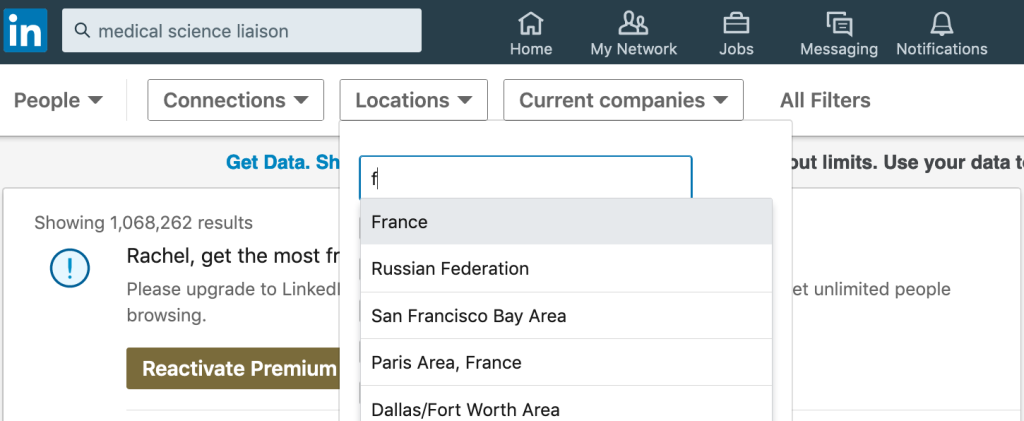Using LinkedIn for careers research
LinkedIN isn’t just an online C.V., an electronic contact address book and job market – it can also be a great tool for researching potential careers. For example, it can help to:
- research the backgrounds of people doing a specific type of role
- get career inspiration by finding people with a similar background or skills set
- find people in your wider network working in your target company or role who you could contact for an informational interview
- find groups discussing career-related topics that interest you
Example 1: Get career inspiration – find people with a similar background or skills set
Using the search bar on the top left of LinkedIn – together with filters – can provide inspiration on non-academic careers, even if you don’t know where to start.
For example, if you are an electron microscopy specialist, you could search for people with electron microscopy mentioned in their profile.
You can then filter e.g. by location or current company directly below the search bar – or access further options, including past company and industry by clicking “all filters”.

A search for electron microscopy with past company EMBL I did found 217 people. In addition to lots of people in academic roles, I found others with a really wide variety of positions including:
- Researchers in big pharma and small biotech
- A “bioprocess scientist” in Pharma
- A corporate partnership manager at a UK university
- People working at large consulting companies
- Someone working as director of scientific strategy and communications at a US technology centre
- At least 2 people working in sales and marketing in industry
You can also search by specific transferable skills e.g. if you think your key skills are project management and data analysis, you could try putting both of these skills in the search bar and see what people & jobs come up.
Example 2: Research the backgrounds of people doing a specific type of role
If you are interested in a particular role – for example, becoming a medical science liaison in France – you can use LinkedIn to research the backgrounds of people with this role.
Using the search bar to find for people with mentioning medical science liaison gave me over a million profiles. I then filtered for people with the in France in the locations filter (>7000 people), and finally used the “all filters” button to access the job title search to find the more than 300 people who had the exact job title “medical science liaison”.

Looking through the profiles of my top 10, I could see that:
- Two had worked in academia in molecular biology areas and went directly from a postdoc to a medical science liaison position. In both cases, they had carried out basic research in biological processes that have a disease link, and they both emphasised that link in their profiles along with their non-scientific skills like project management.
- 7 had a product manager or sales role in industry before transitioning to medical science liaison.
- One did not provide details of their past position
So in this case, the search suggests that it is possible to get a position directly, but this is not the normal path. It may very well be that one or more of the hits is in your wider network or you have some connection to e.g. alumni of somewhere you worked. In that case, you could consider connecting with them for an informational interview, where you can find out more about what hirers are looking for, what the job is like, if the impression that moving directly from research is not the normal path is correct, and if they think it would be advisable to enter via a product manager role.
LinkedIn can also be used to confirm whether a particular job title at a specific company is an entry level role using the current company filter, and looking a a number of people with this role to see what their previous roles were.
Read more about using LinkedIn from others:
http://blog.impactstory.org/7-tips-to-supercharge-your-academic-linkedin-profile/

